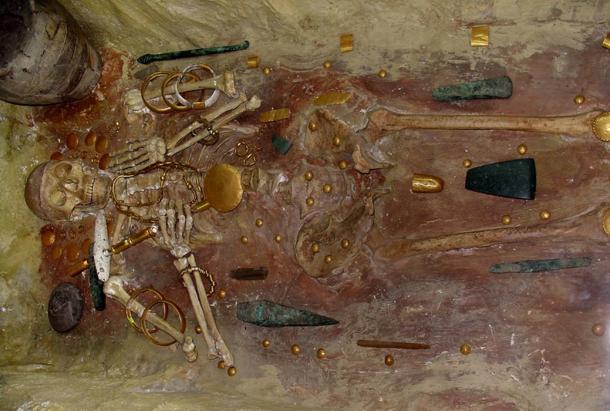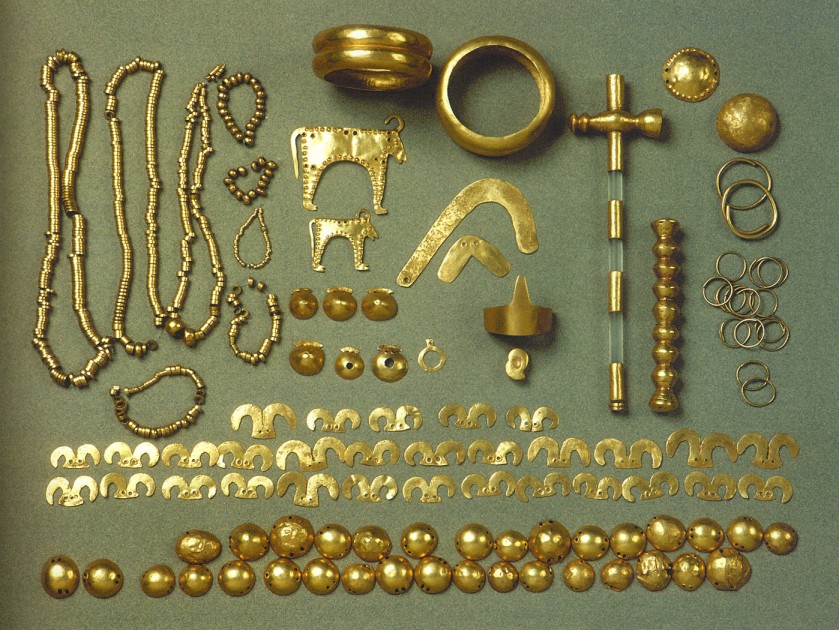Archaeologists in Bulgaria stumbled upon the wealthiest grave of the 5th millennium BC containing the oldest golden artifacts ever found.
The incredible finding by excavator operator Raycho Marinov is one of the most important archaeological discoveries ever made in the country.

Some of the inhabitants’ graves were laden with treasures, including gold ornaments, heavy copper axes, elegant finery, and richly decorated ceramics while others had simple burials with few grave goods.Surprisingly, some graves contained no skeleton at all. Instead, these ‘symbolic graves’ were the richest in terms of the amount of gold and other treasures found within them.
Some of these symbolic graves (cenotaphs) also contained human-sized masks made of unbaked clay placed in the position where the head of the deceased would have been.Varna had a highly structured society
The vast Copper Age necropolis was discovered in the 1970s, but grave 43 stood out the most to archaeologists because of the real implications of the finding.
The archaeologists unearthed the remains of a high status male who appears to have been a ruler or leader of some kind. He was buried with incalculable riches in his grave and with much more gold than was usual.
Elite members of society were buried in shrouds with gold ornaments sewn into cloth wrappings, as revealed from grave analysis. This proved that the Varna culture had a highly structured society.Mihail Lazarov directed the launch of extensive excavations from 1972 to 1976, and Ivan Ivanov directed excavations from 1972 to 1991, revealing the magnificent civilization of Varna.
The first proof of Varna’s ancient civilization came in the form of tools, vessels, utensils, and figurines made from stone, flint, bone, and clay.
Over twenty-two thousand exquisite artifacts were recovered from the graves, including more than three thousand items made from gold with a total weight of six kilograms (13.23 pounds).

More rare relics were also found within the graves, including copper, exceptional flint tools, jewelry, shells of Mediterranean mollusks, pottery, obsidian blades, and beads.An advanced civilization
Great civilizations of Mesopotamia, Egypt, and the Indus Valley have been heard of and noted for being the earliest known civilizations to feature organized administration, urbanization, and cultural innovation.However, only a few people have heard of the peculiar civilization, the Varna culture, that emerged on the shores of lakes near the Black Sea some seven thousand years ago.
Varna, home to the largest known prehistoric necropolis in southeastern Europe, reflects an ancient belief system, a richness in cultural practices and complex funerary rites.
It has come to be known as the cradle of civilization in Europe with the capacity to produce exquisite and expertly-crafted goods.
It was an amazingly advanced civilization and the first known culture to craft golden artifacts. It was older than both the empires of Mesopotamia and Egypt.Rise of goldsmithing and wealth accumulation
Evidence suggests goldsmithing first began in Varna between 4600 and 4200 BC. Craftsmen mastered metallurgy of copper and gold as advances were made. Inhabitants now had something extremely valuable to trade.The inhabitants increased their contacts with neighbors in both the north and south, and this eventually opened up trade relations within the Black Sea and Mediterranean region.
The settlements of Varna and the deep bay provided a comfortable harbor for ships sailing across the Black Sea, and it was of great importance for the development of the society thereby becoming a prosperous trading center.
The metallurgists accumulated wealth, and, immediately, a societal gap developed with metallurgists at the top, followed by merchants in the middle, and farmers making up the lower class.Graves suggest Varna was an organized society
Foundations for the emergence of a powerful and flourishing culture had been laid, and its influence permeated the whole of Europe for thousands of years to come.The burials in the Varna necropolis were significant not only because of the precious artifacts found within them but also due to subsequent discoveries related to social hierarchies.
Incredible discoveries made at a nearby cemetery suggest that Varna had powerful rulers or kings.Varna man was the first male to be buried
The Varna man, as he is known, was buried with a scepter, which was a symbol of high rank or spiritual power, and wore a sheath of solid gold over the phallus.
Women and children are the only ones who received the most elaborate burials, and so this particular burial of the Varna man is incredibly significant not just for the grave goods but because it was the first known elite male burial in Europe.
Marija Gimbutas, a Lithuanian-American archaeologist, suggested that it was at the end of the 5th millennium BC when the transition to male dominance began in Europe.
Gimbutas is well-known for her claims that Neolithic sites across Europe provided evidence of matriarchal pre-Indo-European societies.
It was indeed observed that around this time men began getting the better posthumous treatment in the Varna culture.Wealthy graves provided understanding of religious beliefs
Features of the graves have provided key insights into the religious beliefs and complex funerary practices of this ancient civilization to researchers.
Males and females were laid out in different positions within the graves, with the males lying on their backs and females placed in a fetal position.
Gold amulets in the shape of women were found in these graves, too, placed in the position where the neck would have been.These amulets indicate that the burials were meant for females since they were associated with pregnancy and childbirth.
Furthermore, there were no battle-axes found in these cenotaphs. However, each of them had a copper pin, a flint knife, and a spindle whorl.The legacy and downfall of the culture
The Varna culture was a large and consequential society that emerged in a little corner of what would become modern day Bulgaria, but it quickly disappeared into the pages of history.
The once strong and powerful Varna culture began to disintegrate by the end of the fifth millennium BC.
There have been speculations overtime that the downfall of the Varna civilization was the consequence of a combination of factors, including climate change, which turned large areas of fertile land into marshes and swamps.One other reason for the Varna downfall was the incursion of horse-riding warriors from the steppes.Varna set fundamental principles of a modern society
Members of this ancient culture left behind many lasting legacies and set the stage for the emergence of subsequent civilizations throughout Europe even though the Varna have no modern direct descendants.
Features of their society are characteristic of a highly advanced and developed civilization. Their skills in metallurgy were unmatched in Europe and throughout the world.
They also established the societal structure of a centralized authority—a person or institution to keep watch on and ensure the proper functioning of the society.
Hence, with the Varna, all the fundamental principles of modern society had been set, and, to this day, it is a representation of civilization to which we still conform.





